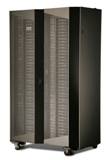The technology landscape is shifting. With the rise of cloud computing, there has been a renewed focus on what’s happening in the datacenter. But it’s not just consumer-grade web apps that are driving this shift – enterprises, too, are looking to virtualize their services and move applications off the desktop in order to better manage client computers and maintain data security.

Recently, HP and research firm IDC took a look at some of the biggest trends they’re seeing in the datacenter. These five hot new trends are having a big impact on computing today and the future of the cloud. But which ones are most important?
According to research from IDC and HP, the following five data center trends are representative of the big shifts happening now in computing:
1) Blades
Blades will account for 29% of server sales by 2012. This market is growing quickly as customers are realizing the benefits of a bladed infrastructure: that is, space, time, cost and energy savings. Both enterprise and midsize customers are being impacted by this trend. (Source: IDC’s Worldwide Quarterly Server Forecast, 2008Q1)
2) Going Green
Going green is less about being environmentally conscious and more about saving money. CIOs and IT managers are surprised to find that creating an energy-efficient, high-performance data center through power and cooling is much less expensive they they anticipated. The end result of going green is a reduction in overall costs (energy, space requirements, management, etc) which is savings businesses some serious dollars.

3) Virtualization
By 2011 more than half of customers’ workloads will be deployed in virtual machines. With every new advancement in this area, like integrated hypervisors for example, the need to intelligently control the data center is strengthened. Data center managers need to know how to build a unified infrastructure combining both the virtual and physical environments. (Source: IDC Multiclient Study, Server Virtualization On the Move 2007)
4) Cloud Computing Means Scalability Is a Must
Data is growing at an exponential rate thanks to cloud computing. Large content-rich data, like streaming digital media (e.g. IPTV, video on demand, broadcast, etc.), static digital media (e.g. photo sharing, online music download, etc.), and web content hosting (e-mail, blogs, Web pages, etc.) are having the most impact. Cloud computing companies need solutions that can easily manage multi-petabyte scalability – without disruption.

5) Linux in the Enterprise
Worldwide Linux server shipments have increased by 35% since 2003. Currently, one out of every five servers runs on Linux and the adoption of Linux servers is expected to grow. The adoption rate will increase by almost 8% by 2012 (Source: IDC, Worldwide Quarterly Server Forecast, 2008 Q1)
If you want to learn more about these trends using a real world example, HP’s Pentel Case Study makes for a good read. This company was able to reduce their datacenter footprint from 5 full racks to 1 by using a combination of blades, storage, and VMWare virtualization. They were also able to reduce their power and cooling needs. Those efforts led to a savings of over $200,000 in three years in reduced maintenance costs alone. Their I.T. department is more agile, Oracle performs up to 80% faster, and they can deploy a server in minutes. In other words, these trends are just about changing needs, they’re also about saving money.
Out of all these trends, which ones are most important? We tend to think that scalability is going to be a big issue going forward, especially with the growth of web apps and their specific infrastructure needs. We’ve already seen what lack of scalability can do to a service – we almost lost Twitter, for example, as demand outpaced their ability to provide the service. Knowing the intelligent audience of readers we have here at RWW, we’re interested in what trends you think are the most important.










